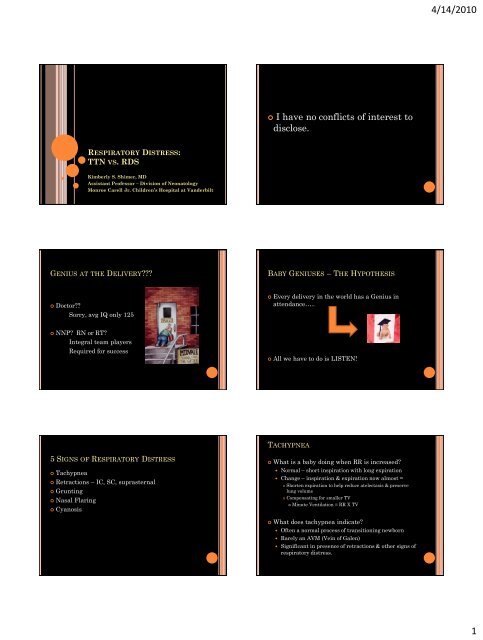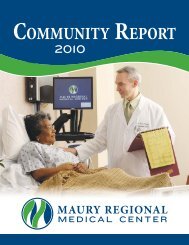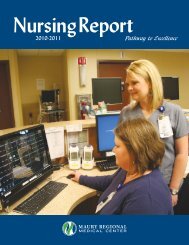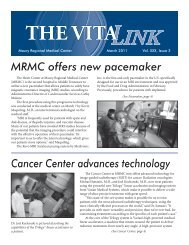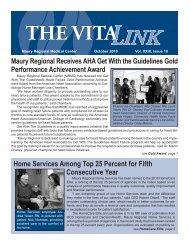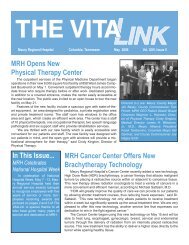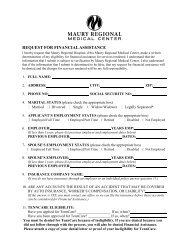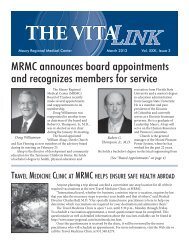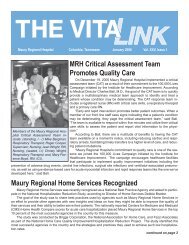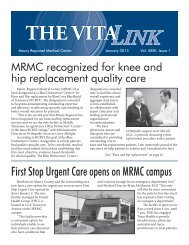Respiratory Distress: TTN vs. RDS
Respiratory Distress: TTN vs. RDS
Respiratory Distress: TTN vs. RDS
Create successful ePaper yourself
Turn your PDF publications into a flip-book with our unique Google optimized e-Paper software.
4/14/2010<br />
I have no conflicts of interest to<br />
disclose.<br />
RESPIRATORY DISTRESS:<br />
<strong>TTN</strong> VS. <strong>RDS</strong><br />
Kimberly S. Shimer, MD<br />
Assistant Professor – Division of Neonatology<br />
Monroe Carell Jr. Children’s Hospital at Vanderbilt<br />
GENIUS AT THE DELIVERY<br />
BABY GENIUSES – THE HYPOTHESIS<br />
Doctor<br />
Sorry, avg IQ only 125<br />
Every delivery in the world has a Genius in<br />
attendance…..<br />
NNP RN or RT<br />
Integral team players<br />
Required for success<br />
All we have to do is LISTEN!<br />
TACHYPNEA<br />
5 SIGNS OF RESPIRATORY DISTRESS<br />
Tachypnea<br />
Retractions – IC, SC, suprasternal<br />
Grunting<br />
Nasal Flaring<br />
Cyanosis<br />
What is a baby doing when RR is increased<br />
• Normal – short inspiration with long expiration<br />
• Change – inspiration & expiration now almost =<br />
Shorten expiration to help reduce atelectasis & preserve<br />
lung volume<br />
Compensating for smaller TV<br />
Minute Ventilation = RR X TV<br />
What does tachypnea indicate<br />
• Often a normal process of transitioning newborn<br />
• Rarely an AVM (Vein of Galen)<br />
• Significant in presence of retractions & other signs of<br />
respiratory distress.<br />
1
4/14/2010<br />
RETRACTIONS<br />
RETRACTIONS<br />
Why do infants have<br />
retractions<br />
• Ribs and sternum are<br />
not as calcified; they<br />
are more cartilaginous<br />
→ more compliant<br />
• Intrathoracic pressure<br />
greater than chest wall<br />
stability<br />
Most likely etiology<br />
• <strong>TTN</strong><br />
• <strong>RDS</strong><br />
• Pneumonia<br />
Less likely etiology<br />
• Space-occupying lesions<br />
• Pleural effusion (chylothorax)<br />
• Upper airway obstruction (inspiratory stridor)<br />
Goldsmith, Karotkin: Assisted Ventilation of the Neonate<br />
GRUNTING – WHAT IS IT<br />
Occurs during expiration<br />
Infant exhales against a closed glottis<br />
Attempt to ↑ intrathoracic pressure<br />
• ↑ alveoli radius → ↓ surface tension → ↓ work of breathing<br />
To prevent alveolar collapse & maintain lung volume<br />
“Auto – Peeping”<br />
Typically heard with respiratory problems like:<br />
• <strong>RDS</strong><br />
• <strong>TTN</strong><br />
• Pneumonia<br />
What else can it be due to<br />
• Septicemia<br />
• Meningitis<br />
NASAL FLARING<br />
Occurs during inspiration<br />
Infant’s attempt to alter their airway resistance<br />
Increase diameter of nasal passage<br />
Decreases upper airway resistance<br />
CYANOSIS<br />
Indicates impaired oxygenation<br />
Most common cause → <strong>Respiratory</strong> disease<br />
Other causes<br />
• Cyanotic Congenital Heart Disease<br />
• Persistent Pulmonary Hypertension<br />
Hypoxia is likely due to:<br />
• A lack of lung surface area for oxygen exchange<br />
OR<br />
• Right-to-left shunt<br />
Pontoppidan, Geffin, Lowenstein: Acute<br />
respiratory failure: the adult. N Engl J Med<br />
CYANOSIS<br />
When can you see cyanosis in an infant<br />
• 5 g/dL of deoxygenated hemoglobin<br />
• Means The more anemic the baby, the lower the<br />
saturations are when cyanosis is visible.<br />
***Use a pulse ox!***<br />
Example:<br />
• NB with typical Hemoglobin of 15 g/dL<br />
• Cyanosis seen when only Hbg 10 is saturated with<br />
O2<br />
• Take home message → Sats in normal NB at time of<br />
noticeable cyanosis will be
4/14/2010<br />
THE GASP OF IMPENDING DOOM!<br />
RESPIRATORY DISTRESS: OUR MOST<br />
COMMON CULPRITS<br />
This is when an infant with respiratory distress<br />
suddenly drops their RR for 80-100’s down into the 20-<br />
30’s.<br />
<strong>Respiratory</strong> <strong>Distress</strong> Syndrome (<strong>RDS</strong>)<br />
BEWARE the tired child there!<br />
Transient Tachypnea of Newborn (<strong>TTN</strong>)<br />
• Aka Retained Fetal Lung Fluid<br />
<strong>RDS</strong> - PATHOPHYSIOLOGY<br />
<strong>RDS</strong> – FUNCTIONAL ABNORMALITIES<br />
Decreased compliance<br />
Increased resistance<br />
Ventilation/perfusion<br />
abnormalities<br />
Impaired gas exchange<br />
Surfactant Deficiency<br />
Increased work of breathing<br />
Goldsmith, Karotkin: Assisted Ventilation of<br />
the Neonate<br />
Downloaded from: StudentConsult<br />
© 2005 Elsevier<br />
<strong>RDS</strong> – RADIOGRAPHIC APPEARANCE<br />
<strong>RDS</strong> – CLASSIC PRESENTATION & COURSE<br />
Inversely proportional to gestational age<br />
24 weeks, >80%<br />
28 weeks, 70%<br />
32 weeks, 25%<br />
36 weeks, 5%<br />
Dx → clinical, radiographic, laboratory<br />
• ABG – PaO2 ↓, PaCO2 usually increased, pH may have<br />
both respiratory and metabolic acidosis<br />
Worse before better<br />
• Peak severity at 1-3 days<br />
• body needs time to ramp up production of surfactant<br />
Recovery begins at ~72 hours, usually with diuresis<br />
Downloaded from: StudentConsult<br />
© 2005 Elsevier<br />
3
4/14/2010<br />
PRENATAL TX & CONDITIONS AFFECTING <strong>RDS</strong><br />
<strong>RDS</strong> – THERAPEUTIC STRATEGIES<br />
What can delay pulmonary maturation<br />
• Maternal diabetes<br />
• Rh-sensitized fetuses<br />
• Maternal hypothyroidism<br />
• Hypothyroid infants<br />
What can accelerate pulmonary maturation<br />
• IUGR<br />
• Maternal Drug abuse<br />
• Prolonged rupture of membranes<br />
What antenatal treatment has had the biggest<br />
impact in improving outcome of <strong>RDS</strong><br />
• Betamethasone/Dexamethasone<br />
From Cotton R: Semin Perinatol 18:19, 1994.<br />
<strong>Respiratory</strong><br />
• Airleaks<br />
PTX<br />
PIE<br />
<strong>RDS</strong> – COMPLICATIONS OF TX<br />
STRATEGIES<br />
pneumomediastinum/pericardium/peritoneum<br />
subQ emphysema<br />
• Airway injury<br />
• Pulmonary hemorrhage<br />
• CLD/BPD<br />
PDA<br />
Neurologic – IVH, PVL<br />
Pneumonia and sepsis<br />
<strong>TTN</strong> - PATHOPHYSIOLOGY<br />
Delayed clearance of fetal lung fluid<br />
Polin, Fox, Abman: Fetal & Neonatal Physiology<br />
<strong>TTN</strong> – FUNCTIONAL ABNORMALITIES<br />
<strong>TTN</strong> – RADIOGRAPHIC APPEARANCE<br />
Decreased pulmonary compliance<br />
Decreased TV<br />
Classic x-ray features<br />
At Birth<br />
3 Days of age<br />
Increased dead space<br />
4
k<br />
4/14/2010<br />
<strong>TTN</strong> – CLASSIC PRESENTATION & COURSE<br />
Mild respiratory distress that typically improves<br />
steadily over time<br />
Usually resolves by 24 – 48 hours of life, but can<br />
last up to 5 days<br />
May need CPAP, but rarely requires more than<br />
30% FiO2<br />
Can complicate <strong>RDS</strong><br />
<strong>TTN</strong> – PREDISPOSING CONDITIONS<br />
C-section<br />
Precipitous<br />
delivery<br />
Very small,<br />
hypotonic infants<br />
Sedated infants<br />
EVALUATION<br />
FOR<br />
RESPIRATORY FAILURE<br />
RESPIRATORY FAILURE<br />
Silverman-Anderson Retraction Score ≥ 7<br />
LANGUAGE OF<br />
INTERPRETATION<br />
Goldsmith, Karotkin: Assisted Ventilation of the Neonate<br />
RESPIRATORY FAILURE<br />
Defined by blood gas:<br />
• PaO2 < 60 mmHg<br />
• PaCO2 > 60 mm Hg<br />
Pontoppidan, Geffin, Lowenstein: Acute respiratory<br />
failure: the adult. N Engl J Med<br />
LAST THOUGHTS – DIFFERENTIAL DX<br />
<br />
Which is more helpful with dx<br />
History<br />
OR<br />
Physical exam, x-ray & lab work<br />
HISTORY!<br />
Goldsmith, Karotkin: Assisted Ventilation of the Neonate<br />
5
4/14/2010<br />
QUICK GAME – WHAT’S THE DX<br />
26 weeker <br />
40 weeker, c-section <br />
36 weeker, Infant of Diabetic mother <br />
UNCERTAIN DIAGNOSIS STRATEGERY<br />
Based on possible Pulmonary and Non-Pulmonary<br />
Diseases<br />
Oxygen<br />
CPAP<br />
Surfactant – even if term, now used with<br />
meconium aspiration, pneumonia, etc…<br />
95% of the time, History yields Dx<br />
Antibiotics<br />
If you have any concern for CHD → start prostins<br />
Monitor BP and blood sugar → treat as needed<br />
T-PIECE RESUSCITATOR (NEOPUFF)<br />
Strength – consistent ventilation in midst of crisis<br />
Caution! Opening pressure can be 40-60<br />
• Watch for adequate chest wall movement<br />
• Change ventilation strategy if needed<br />
Remember….. In the delivery room…<br />
#1 way to get HR up is adequate<br />
ventilation!!!<br />
Move the Chest!<br />
X-RAY VISION<br />
To determine if surgical intervention<br />
is needed<br />
Downloaded from: StudentConsult<br />
© 2005 Elsevier<br />
6
4/14/2010<br />
<strong>TTN</strong><br />
<strong>RDS</strong><br />
<strong>RDS</strong><br />
<strong>TTN</strong><br />
<strong>TTN</strong><br />
<strong>RDS</strong><br />
7
4/14/2010<br />
<strong>TTN</strong><br />
<strong>RDS</strong><br />
<strong>RDS</strong> WITH <strong>TTN</strong><br />
QUESTIONS<br />
PIE WITH PTX<br />
SEVERE PIE<br />
8
4/14/2010<br />
<strong>RDS</strong> WITH CHEST TUBE<br />
FULL TERM AT BIRTH<br />
Note significant respiratory distress and<br />
scaphoid abdomen<br />
So, you obtain an x-ray…..<br />
CONGENITAL DIAPHRAGMATIC HERNIA<br />
Collapsed lung due<br />
to air in bowel<br />
41 WEEK, THICK MECONIUM<br />
You attend the delivery and infant starts crying<br />
before you can intubate and suction at the cords.<br />
Infant develops increasing respiratory distress,<br />
you place him on 100% FiO2 and he begins to<br />
desat easily with the slightest stimulation.<br />
So, you order an x-ray….<br />
MECONIUM ASPIRATION<br />
Infant suddenly desaturates on 100% FiO2 on vent<br />
X-ray<br />
pneumothorax<br />
9


